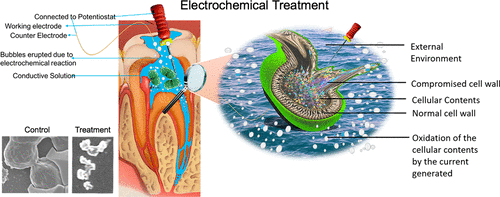当前位置:
X-MOL 学术
›
ACS Biomater. Sci. Eng.
›
论文详情
Our official English website, www.x-mol.net, welcomes your
feedback! (Note: you will need to create a separate account there.)
Total Eradication of Bacterial Infection in Root Canal Treatment: An Electrochemical Approach
ACS Biomaterials Science & Engineering ( IF 5.4 ) Pub Date : 2018-06-04 00:00:00 , DOI: 10.1021/acsbiomaterials.8b00136 Abhijith Segu 1 , Divya Bijukumar 1 , Tina Trinh 1, 2 , Manila Nuchhe Pradhan 2 , Qian Xie 2 , Sukotjo Cortino 2 , Mathew T. Mathew 1, 2
ACS Biomaterials Science & Engineering ( IF 5.4 ) Pub Date : 2018-06-04 00:00:00 , DOI: 10.1021/acsbiomaterials.8b00136 Abhijith Segu 1 , Divya Bijukumar 1 , Tina Trinh 1, 2 , Manila Nuchhe Pradhan 2 , Qian Xie 2 , Sukotjo Cortino 2 , Mathew T. Mathew 1, 2
Affiliation

|
According to the American Association of Endodontists, currently 22.3 million endodontic procedures are being performed annually with the success rate of 70–95% and the average survival rate of the root canal procedure is approximately 67% after 5 years and 56% after 8 years. One of the major reason for the failure is relapse of infection. Hence, it is imperative to develop an assistive or alternative method to eradicate the bacterial infection effectively without affecting patient compliance. The application of electrochemistry has been used previously to disinfect catheters and implant disinfection. Hence, the aim of this study is to utilize the principles of electrochemistry to develop a microelectronic device to eradicate bacterial infection for root canal treatment. The electrochemical protocol includes open circuit potential (60 s) and potentiostatic scan at varying voltage (−9 to +2 V) at a different time duration (1–5 min). Enterococcus faecalis in the form of planktonic and biofilm was used in this study. After electrochemical treatment, the bacterial viability was evaluated using alamarBlue assay, colony forming units, confocal microscopy, and scanning electron microscopy. Cytotoxicity evoked by electrochemical voltage in comparison to NaOCl solution was performed using osteoblasts in 2D and 3D cell culture systems. The results of the study show that the application of −2 to +2 V at 1–5 min did not show any significant reduction in bacterial growth. However, the cathodic voltage of −9 V for 5 min showed a significant reduction (p < 0.001) in the bacterial count (80–95%). Similar results were obtained from biofilm study, which is more realistic to the in vivo condition. In contrast, the method did not induce cytotoxicity to the cells in 3D culture system (65% viability) in comparison to the highly toxic nature (0% viability) of NaOCl, indicating better patient compliance. Hence, the study provides supporting evidence to develop an electrochemically driven microelectronic device that can be a potential assistive dental instrument for endodontic procedures.
中文翻译:

在根管治疗中彻底根除细菌感染:一种电化学方法
根据美国牙髓医师协会的资料,目前每年进行2230万例牙髓手术,成功率为70-95%,根管手术的平均存活率在5年后约为67%,在8年后约为56%。失败的主要原因之一是感染的复发。因此,迫切需要开发一种辅助或替代方法,以在不影响患者依从性的情况下有效根除细菌感染。电化学的应用先前已被用来对导管进行消毒和对植入物进行消毒。因此,本研究的目的是利用电化学原理来开发微电子设备,以根除细菌感染以进行根管治疗。本研究使用了浮游生物膜和生物膜形式的粪肠球菌。电化学处理后,使用alamarBlue分析,菌落形成单位,共聚焦显微镜和扫描电子显微镜评估细菌的生存力。与NaOCl溶液相比,电化学电压引起的细胞毒性是在2D和3D细胞培养系统中使用成骨细胞进行的。研究结果表明,在1-5分钟时将−2施加至+2 V并没有显示出细菌生长的任何明显降低。但是,−9 V的阴极电压在5分钟内显示出显着降低(p<0.001)的细菌计数(80–95%)。从生物膜研究中获得了相似的结果,这对于体内条件而言更为现实。相比之下,与NaOCl的高毒性性质(0%生存力)相比,该方法在3D培养系统中没有诱导对细胞的细胞毒性(生存力为65%),表明患者的依从性更好。因此,该研究为开发电化学驱动的微电子器件提供了支持性证据,该器件可以成为牙髓手术的潜在辅助牙科器械。
更新日期:2018-06-04
中文翻译:

在根管治疗中彻底根除细菌感染:一种电化学方法
根据美国牙髓医师协会的资料,目前每年进行2230万例牙髓手术,成功率为70-95%,根管手术的平均存活率在5年后约为67%,在8年后约为56%。失败的主要原因之一是感染的复发。因此,迫切需要开发一种辅助或替代方法,以在不影响患者依从性的情况下有效根除细菌感染。电化学的应用先前已被用来对导管进行消毒和对植入物进行消毒。因此,本研究的目的是利用电化学原理来开发微电子设备,以根除细菌感染以进行根管治疗。本研究使用了浮游生物膜和生物膜形式的粪肠球菌。电化学处理后,使用alamarBlue分析,菌落形成单位,共聚焦显微镜和扫描电子显微镜评估细菌的生存力。与NaOCl溶液相比,电化学电压引起的细胞毒性是在2D和3D细胞培养系统中使用成骨细胞进行的。研究结果表明,在1-5分钟时将−2施加至+2 V并没有显示出细菌生长的任何明显降低。但是,−9 V的阴极电压在5分钟内显示出显着降低(p<0.001)的细菌计数(80–95%)。从生物膜研究中获得了相似的结果,这对于体内条件而言更为现实。相比之下,与NaOCl的高毒性性质(0%生存力)相比,该方法在3D培养系统中没有诱导对细胞的细胞毒性(生存力为65%),表明患者的依从性更好。因此,该研究为开发电化学驱动的微电子器件提供了支持性证据,该器件可以成为牙髓手术的潜在辅助牙科器械。











































 京公网安备 11010802027423号
京公网安备 11010802027423号